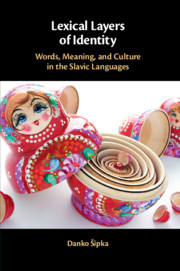Lexical Layers of Identity
Focusing on Slavic languages, Danko Šipka provides a systematic approach to lexical indicators of cultural identity. In contrast to existing research, which focuses heavily on syntactic and phonological approaches, Šipka's approach is novel, more systematic and encompassing, and postulates three lexical layers of cultural identity: deep, exchange, and surface. The deep layer pertains to culture-specific words, divisions, and features that are generally not subject to change and intervention. The exchange layer includes lexical markers of cultural influences resulting from lexical borrowing, which situates the speakers into various cultural circles. This layer is subject to gradual changes and some limited level of intervention from linguistic elites is possible. Finally, the surface layer encompasses the processes and consequences of lexical planning. It is subject to abrupt changes and it is shaped in constant negotiation between linguistic elites and general body of speakers.
- Proposes a more systematic and more encompassing way of studying the nexus of language and culture
- Provides a linguistic approach where the lexicon and lexical peculiarities play a central role, in contrast to the dominant syntactic and phonological approaches in global linguistics
- Revives Slavic studies by positioning the material at the front and centre of the research, rather than using it to simply exemplify general linguistic points
Product details
October 2021Paperback
9781108716963
284 pages
229 × 152 × 16 mm
0.416kg
Available
Table of Contents
- 1. A conceptual map
- 2. Relevant research traditions
- 3. Research methodology
- 4. Lexeme-level culture-bound words, divisions, and features
- 5. Lexicon-based culture-bound field density
- 6. Stability and change
- 7. Cultural influences
- 8. Geographical contact
- 9. Inbound and outbound exchange
- 10. Lexical planning
- 11. Lexicographic traditions
- 12. Attitudes
- Conclusion
- 13. Interaction between the layers
- 14. Main findings
- 15. An outlook.






